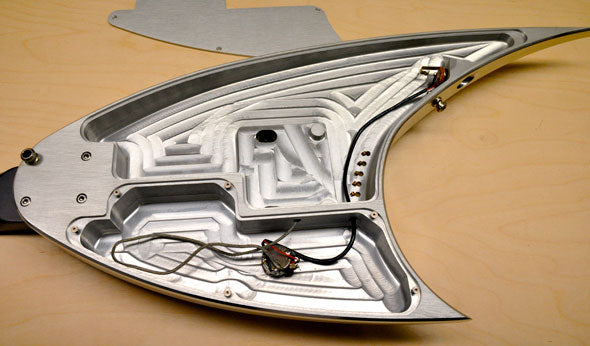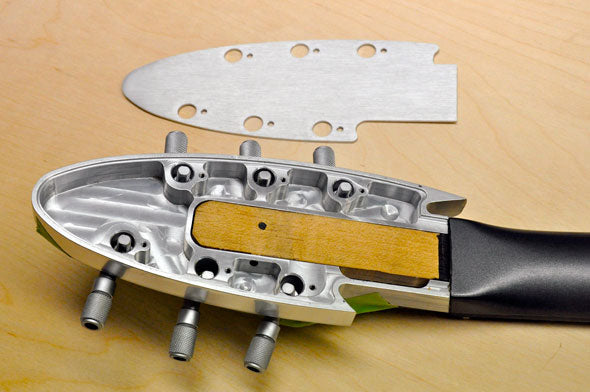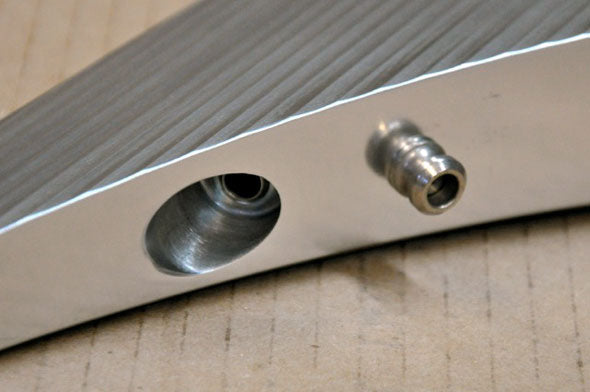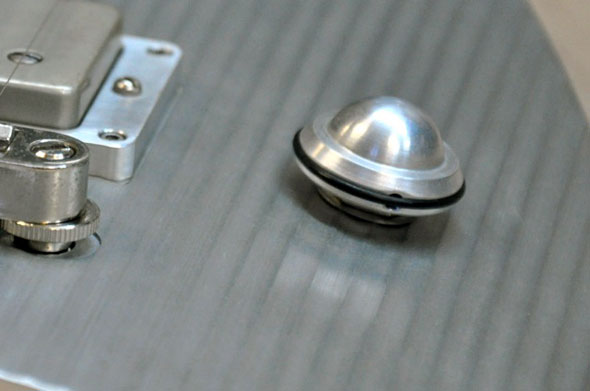A History Of The Jackson Roswell Rhoads Guitar

Alien abductions. They always seem to happen the same way. You are tucked safely into your bed, drifting off into dreamland then… WHAMMO! your body is strapped down to an examination table inside a spacecraft and you’re face to face with a weird, glowing humanoid holding a probe. Uh oh. Wouldn’t it be nice if instead of scars and life-long nightmares, the aliens brought us awesome new guitars? Enter the Jackson Roswell Rhoads, the legendary all-aluminum guitar from the 1990s that is as rare as a real UFO sighting. It’s unlike any guitar you’ve ever seen before.
We’d like to share some history with you on this crazy guitar that has become implanted in our imaginations at The Music Zoo (we’ve even built some of our own Jackson Roswell-inspired guitars). In the mid-1990s, Charles Perrino – marketing director for Jackson/Charvel at that time, as well as a huge alien and sci-fi buff – woke up one during the night with a clear vision of a brand new guitar design. It came from a dream, he said. A lot of the information about the creation of the Roswell is anecdotal, and we owe a big thanks to Tim Wilson who was instrumental in putting together this history. Tim began his career at Charvel/Jackson in 1979 as Grover Jackson’s primary woodworker, eventually rising through the ranks to become the plant manager of US operations from 1992 until his retirement in 2007. He now builds instruments in his own shop for Sugi Guitars of Japan as well as making his own brand of ‘TP Wilson’ guitars.
Now, we are going to reveal some of the secrets of this infamous guitar that came to us from a mysterious, faraway place. Tim provided us the following transcript of a conversation he had with Mike Johnson, who was Charles Perrino’s assistant in the mid-’90s:
[TW]: Do you remember what he told you about the dream?
[MJ]: Not really… it was something about a futuristic guitar floating in outer space.
Did he sit down and draw a sketch or something?
No. He just told me about his idea. Kind of described it to me. I had just gotten Autocad on my computer, so I started designing stuff.
So the shape of the body was your idea? It looks a little like the old Star Trek logo that they had on their polo shirts, you know, the old show from the Sixties. Was that intentional or did it just pop out that way?
It just came out like that. There was a sports show on ABC that had something similar in the corner of the screen. Maybe it came from there.

What about the pickup? It was a Tom Holmes, wasn’t it?
Charles had this pickup sitting around with a nickel cover, so we stuck it on there because we thought it looked cool. There really wasn’t much thought about whether or not it was a Tom Holmes.
That pickup turned out to be the right choice, it was a high output design that really lent to the ‘metal’ image of the guitar. What about the tuners?
Yeah, we put LSR’s on it because the were so space-agey, it really fit the vibe.
 Who came up with the idea for the inlays? I know they were done by Dwight England of Custom Inlay in Kentucky. I seem to remember sitting down at a computer downloading pictures of crop circles from the internet and sending them to him…
Who came up with the idea for the inlays? I know they were done by Dwight England of Custom Inlay in Kentucky. I seem to remember sitting down at a computer downloading pictures of crop circles from the internet and sending them to him…
I don’t really remember, that’s kind of vague. You know, this was just meant to be a concept guitar at first. Kind of like those cars that Detroit puts out for a trade show, never really intending to actually make them. We put it on the cover of the catalog and took it to NAMM. We were blown away by the response, everybody wanted one. So yeah, we thought if people were willing to pay for it, we should make a few.
I remember we made them in small batches, like 15-20 at a time. We’d finish one batch and have to make another. In the end I think we made about 100 of them.
Really? It was that many?
Yup. Do you remember that teenage band in the nineties, Hansen? I remember seeing pictures of them playing one at a show.
No, I don’t remember the Hansen thing. But we did give one to Marty Friedman…
Tim also provided us with the following technical information about the Roswells:
The aluminum bodies and pegheads were CNC’d by a company called Numericon in the San Fernando Valley. The inside is hollowed out to reduce the weight:

In spite of the aluminum design, the guitar weighs in at around 8-1/2 pounds, about the same as a Les Paul, so it’s not as bad as you might think. The large back plate was glued in with silicone, not meant to be removed. You could do some damage if you try to take it off. After getting the bodies from Numericon, they were scuffed to remove as much of the machining marks as possible, then they were sent out for clear anodizing. Aluminum will give off a black smudge on your hands if you don’t do that. All the guitars were done this same way except for one– #RSW057, which was gold anodized instead of clear… sure would like to know where that one is! The necks were made in-house at Jackson, and the peghead was attached with a clever tongue-and-groove system:

The wood was maple with ebony, with black binding around the fingerboard. (We always put black binding on ebony fingerboards before painting… the urethane and polyester coatings we used didn’t adhere to ebony very well, but would stick to cellulose binding just fine). The neck is attached to the body with machine screws instead of wood screws, which means we had to drill and tap the four holes in the neck just like a machine shop would. Be careful if you decide to take the neck off one of these.  It’s a stock Gotoh Tune-0-matic bridge.
It’s a stock Gotoh Tune-0-matic bridge.
 We put Schaller strap locks on it for extra security.
We put Schaller strap locks on it for extra security.
 I don’t remember in who made the UFO knobs for us, but you gotta admit they’re pretty cool!
I don’t remember in who made the UFO knobs for us, but you gotta admit they’re pretty cool!
Serial Number Information
This information was pulled directly from Jackson’s logbooks. The first Roswell was number RSWL-1, completed in December of 1995, and displayed at the Namm show in January of ’96. The logbook shows that the first production model shipped at the end of March, so it only took a couple months to get things into gear. It was serial number RSW001 (the production models dropped the “RSWL” designation from the serial number). The last one was RSW125, shipped on 1-13-98. Towards the end Jackson began making them out of wood. #103 was Tobacco Sunburst, #108 was Interference paint, and #109 says “rainbow” in the logs. That means that there were 123 aluminum roswells produced (including the NAMM sample) over the course of two years.
The logbook continues after that, numbers 126 through 142 were all wooden ones, including some variations like the ‘Roswell Star’, which was this weird looking Roswell shape with a horn added to it, and a phosphorescent one that glowed in the dark (#126). The last one listed in the book was a left-handed chlorine quilt-top version made in January of 1998.
Have any questions about Jackson guitars, or aliens in general? Our sales team is here to help. Drop us a line at sales@themusiczoo.com.





